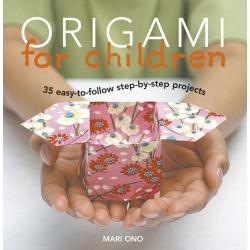Origami for Children: 35 Easy-To-Follow Step-By-Step Projects

Cico books , 2008, 128 pages. Hardback, £14.99. ISBN 13: 978-1906094386
Review by Anna Davis
This time two years ago, I remember feverishly wiping my brow as I attempted to teach my then class of five year olds how to make an origami heart for their Valentine’s cards, fumbling and stumbling through my own ineptitude, whilst all the time trying to appear in control of my hands. So when “Origami for Children” by Mari Ono and Roshin Ono landed on my desk, it was with some trepidation that I opened it. What a pleasant surprise, then, to discover it to be straightforward and enjoyable to use, a colourful book that is, crucially, user-friendly.
I followed the photographs and simple instructions and was delighted to find that my own efforts looked surprisingly similar to those in the book (a rare event for me when following any sort of illustrated set of instructions). Next I did a little outsourcing, and was pleased to hear of similarly favourable outcomes produced by both a teenager and a six year old. It’s the sort of book you’ll actually want to use as it’s very good for the ego – your chances of recreating the varied projects, with minimal intervention from a more adept friend/neighbour/child are high.
The book begins with a short introduction and explanation, and helpfully, a chart explaining the meaning of the various arrows used throughout. The projects themselves are presented in six categories – toys, origami fun, animals, party time, sweets and foods and vehicles. Creations range from the more traditional “fusen” (balloon) and “kabuto” (samurai helmet) to the contemporary hot dog and an ever-practical teddy bear’s necktie. Most projects can be made with standard origami paper, although some of the animals and foods (millefeuille, anyone?) will be more effective if made with specially printed origami, or plain paper and an artistic hand. Each project is given a difficulty rating and there is a good balance of levels.
The book also includes a guide to suppliers in the UK and with this information you have all the tools to start folding away. “Origami for Children” would make an ideal present for an artistic child, a useful resource for teachers and parents and an ideal introduction to origami for adults as well. I may even consider giving those origami hearts another try…

